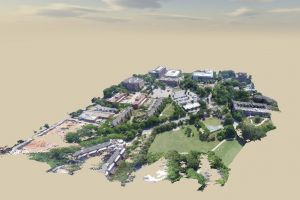|
The SDX project is applying the principles of Software Defined Networking and Infrastructure to the problems of peering between network operators and service providers. This work seeks to overcome the traditional limitations of peering protocols such as BGP to enable operators and their customers to express rich, application-specific policies that facilitate the integration of cloud computing and virtualization into numerous applications.  |
Students in the Sonification Lab and Center for Music Technology designed Solar System Sonification, an auditory experience of the planets. Using non-speech audio to convey information, they built a musical model of the solar system. Planetariums typically rely on visuals with various levels of speech description, but have not explored using auditory cues to present information about space. Auditory displays, like the ones developed for Solar System Sonification, enable more immersive experiences and make information accessible to people with visual impairments. |
Solid SketchLab: SolidSketch is a solid modeling program that enables users to rapidly construct 3D models through sketch and multi-touch input. The interaction design principles of SolidSketch are based on the cognitive science theory of enaction. This paper uses the enaction theory as a lens to describe why the interaction designs of conventional CAD tools often fail to support early stages of the design process. We argue enactive interactions would support design creativity by enabling rapid iteration and continuous feedback throughout a flexible design exploration.  |
The Sonified Fantasy Sports project has been exploring various ways to add sounds to online (web or mobile apps) fantasy sports in an attempt to make a more immersive user experience while also adding to the accessibility of fantasy sports for visually impaired or print disabled users. After identifying information needs and various strategies employed by users (who ranged from beginners to power users) we were able to identify a hierarchy in which to present information about my team and players using sound.  |
|
Sound Happening is a collaborative music-making installation that allows several people to explore and create music in a space by playing with colorful bouncy balls. Using a webcam and Max/MSP, Sound Happening tracks each ball's location relative to the space to manipulate and trigger various samples, resulting in intriguing sound combinations that are constantly changing as the balls move.  |
SoundCage is an installation that allows people to solve an aural puzzle using their entire body. Audience members enter a phone booth sized enclosure and find themselves surrounded by a network of strings. As they move around and touch the strings, their body position will warp the sounds playing all around them. Different movements will result in different sounds, and the audience is encouraged to reveal the hidden message in the soundscape. |
The Space Table is an interactive informal experience to teach children about the formation of solar systems and how gravity, and mass play a role in their creation. Additionally, the project will explore the concepts of different celestial bodies such as stars, planets, asteroids, neutron stars, black holes, and others. The installation will make use of three tangibles, one for a different star size. Interactors will use the tangibles to “stamp” a star on the table, which will spawn a digital star. |
Visualization tools for spatiotemporal data utilize map-based representations to help a user understand trends and outliers within a given region over time. Multitouch visualization tools allow us to recreate many of the capabilities of sketching directly on maps while still taking advantage of computational models of public safety. We will be demonstrating SpaceSketch, a multitouch approach to spatiotemporal visualization. Visitors will be allowed to explore crime and transmit data in the city of Atlanta using our high-resolution Surface Hub Interface.  |
|
Social Participation and Navigation (SPAN) is an intervention that integrates mobile app-based training and "peer coach" support around key aspects of social participation, including social communication and problem-solving skills, identification and remediation of barriers to participation, and establishment of social connections with others. |
Sparse Tangibles investigates the use of novel tangible and gestural interactions for making sense of large biological datasets. Our current prototype employs active tangibles in combination with a large multi-touch tabletop displays to navigate and visualize gene regulatory network data from the BioGrid database.  |
Spatial data visualizer is in-browser application used for visualizing point cloud data which is derived from process of photogrammetry.  |
In this project, I designed and developed a research dashboard for researchers to better understand Speech on Twitter.  |
Spidey Sense Lab: We designed and implemented a novel smartwatch wristband, Spidey Sense, that can produce expressive and repeatable squeezing sensations and effectively explore the design space of squeezing patterns  |
Self-powered Paper Interfaces (SPIN) combining folding paper creases with triboelectric nanogenerator (TENG). Embedding TENG into paper creases, we developed a design editor and set of fabrication techniques to create paper-based interfaces that power sensors and actuators.  |
This study will seek to understand diverse stakeholders' perspectives in AI research and their collaboration and conflicts in the research process. More specifically, we will conduct a case study of the THRIVE project that aims to create novel AI technologies to support mental health patients |


